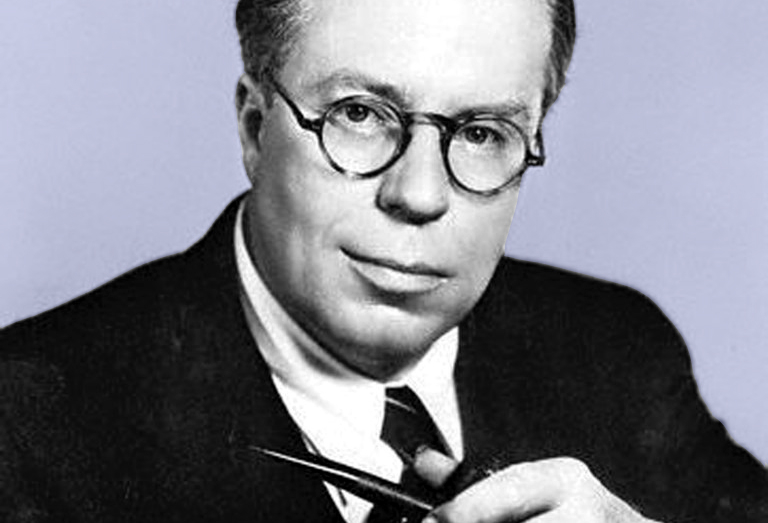
In 1934, writer and editor Christopher Morley founded The Baker Street Irregulars, a group that was once considered the preeminent Sherlockian group in the United States.
To The Sunday Times
The Baker Street Irregulars, of New York
On a foggy and drizzling evening in January 1950, at a club in New York City, fifty men drank a standing toast. It was in regret and homage to their own boyhoods; it was occasioned by the soon approaching demise of the Strand Magazine. Some thirty of the convives were members of the Baker Street Irregulars, a club whose membership is limited to sixty—the number of the Sherlock Holmes stories. The others were delegates from “scionist” societies, viz. satellite chapters from other faubourgs or cities, of which there are about thirty.
Surely it is a unique tribute to an author whose name, officially, is never mentioned. The traditional mystique is that Holmes and Watson are so much more real than their creator that except by privilege from the Chair (known as the Gasogene) the Agent is never mentioned by name.
Whatever decision the British electorate may reach at the forthcoming polls, nothing can ever change the world-wide magic and renown of Holmes and Watson. They are fixed in parallax; dioscuri of modern fiction; stylized as the lion and the unicorn. I know even less about economics than Lord Beveridge, but I suspect that Holmes and Watson are the largest and most luscious of Britain’s Invisible Exports.
And (since you insist) the Baker Street Irregulars, of New York, now enjoying their sixteenth year of lively homage, actually began with four schoolboys in Baltimore about the year 1902. They called themselves then, and still do, The Sign of the Four. One is the senior professor of Greek at Harvard; one is a physicist of the Naval Research Laboratory in Washington, and knows more than anyone needs to about undersea explosions; one is a renowned physician in Baltimore; and the last is your reporter.
The fundamental doctrine of the S.S.I., when they set aside for an evening the irrelevant trivialities of their own lives, is that the Holmes-Watson saga (officially denominated by Mr. Elmer Davis “The sacred writings”) is more actual, and more timely, than anything that happens to ourselves or happened to its mortal mouthpiece. The greatest art is the annihilation of art.
With profound insight the B.S.I. have adopted as their colours the three shades of Holmes’s dressing-gown. It faded, as all mortal energies do: from royal purple to blemished blue; from heliotroped blue to mouse. Mouse, by the way, was the colour of the settees in Simpson’s famous Chess Divan, as reported in R.L.S.’s New Arabian Nights, from which A.C.D. unconsciously borrowed so much.
So the B.S.I. published for three years a quarterly journal (whose motto was “When was so much written by so many for so few?”), but if you can get from your bookseller (Argus Bookshop, Mohegan Lake, N.Y.) those three volumes you will have the best winter evening reading of a lifetime. Myself, I would rather have them than a first Bristol Cream of Wordsworth and Coleridge’s Lyrical Ballads.
Wordsworth and S.T.C. were also greatly anxious about affairs in 1798. But now we need to know, as Holmes asked Watson, “What do you know of the black Formosa corruption?” How I would have loved to ask Madame Generalissima Chiang that question, just before she took off by plane lately—she is, obviously, the Irene Adler of South-East Asia.
Or when Holmes spent the great hiatus (1891-94) in Tibet, wasn’t he making arrangements sixty years ahead for what’s getting ready now? Or the reptilian Moriarty, oscillating his cobra brow over the dynamics of an asteroid, was doubtless precursing uranium and hydrogen bombs, all fission spent. What could the great untold story of the Politician, the Lighthouse, and the Trained Cormorant have suggested but the career of Sir Stafford Cripps?
These are the hints the B.S.I. follow through. Why did passengers on the G.W.R. have to take lunch at Swindon? Exactly how (and with what type scalpel) do you nick the tendons of a horse? What was the precise layout of the rooms in Baker Street? Was Sherlock illiterate, I mean could he read? Why did Watson always have to read aloud to him all letters and telegrams? Why did Holmes never eat fish, but always game, beef, and boiled eggs? Why did he never drink tea? Why was he such a poor marksman? These are the paraleipses or paralipomena to which we devote the most innocent diversion of our lives.
Myself, I do not wholly agree with the tradition that A.C.D. should never be formally mentioned. I loved him long before his heirs and assigns and agents were born, and I find in his writings the most delicious asymptotes to the Holmes-Watson codex. As I have often said, how ridiculous he was only Knighted—he should have been Sainted.
My Christmas carol of the last year was this:
What opiate can best abate
Anxiety and toil?
Not aspirins, nor treble gins,
Nor love, nor mineral oil—
My only drug is a good long slug
Of Tincture of Conan Doyle.
Christopher Morley
29 January 1950


